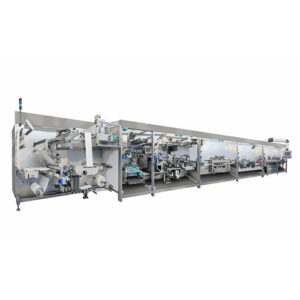Sanitary napkin machines are operated through a series of steps and processes to produce sanitary napkins. Here’s an overview of how they’re typically operated:
- Preparation and Setup: Before starting the machine, operators ensure that all necessary raw materials (such as absorbent core, top sheet, back sheet, and adhesive) are available and loaded onto the machine.
- Machine Startup: Operators power on the machine and initialize the necessary systems for operation. This includes setting parameters such as size, thickness, and materials to be used for the sanitary napkin.
- Material Feeding: The machine’s feeding system takes in the various layers of materials needed for the napkin (absorbent core, top and back sheets) in the predetermined order and arrangement.
- Cutting and Shaping: The machine cuts and shapes the materials into the desired size and shape for the sanitary napkin, forming the core, attaching the layers, and creating wings or adhesive strips if required.
- Compression and Sealing: The formed napkins go through compression to ensure proper adhesion of layers and sealing of edges to prevent leakage. Heat or pressure may be used for sealing purposes.
- Quality Control: Throughout the process, operators conduct quality checks, visually inspecting the napkins for defects, irregularities, or proper alignment of components. Any flawed products are removed or rectified.
- Packaging: Once the sanitary napkins pass quality control, they are packed and prepared for distribution. Packaging can include wrapping individual napkins, bundling multiple napkins, or placing them into larger packs for shipping.
- Maintenance and Cleaning: Regular maintenance, cleaning, and minor adjustments to the machine are performed to ensure consistent operation and prevent issues that could affect production quality.
- Shutdown Procedures: When the production run is complete or during breaks, operators follow shutdown procedures to power off the machine safely and prepare it for the next operation.
Operating a sanitary napkin machine requires training to understand the machine’s controls, sanitary napkin machine handling of materials, conducting quality checks, and troubleshooting common issues that may arise during production. Regular monitoring and adherence to standard operating procedures are essential to ensure the quality and efficiency of the manufacturing process.
What types of materials can an sanitary napkin machine handle?
Sanitary napkin machines are designed to handle various materials that constitute the different layers of a sanitary napkin. These materials include:
- Absorbent Core Materials: These materials form the core of the napkin and are responsible for absorbing and retaining menstrual flow. They can include fluff pulp, superabsorbent polymers (SAP), and other absorbent materials.
- Top Sheet Materials: The top sheet is in direct contact with the user’s body. It’s typically made of non-woven fabrics, perforated film, or cotton-like materials for comfort and quick absorption.
- Back Sheet Materials: This is the outer layer of the napkin that prevents leakage and provides a barrier between the absorbent core and clothing. Back sheet materials often include breathable films, non-woven fabrics, or moisture-proof materials.
- Adhesive and Fastening Materials: Some napkin designs include adhesive strips or fastening mechanisms to secure the napkin in underwear. These materials could be pressure-sensitive adhesives or glue.
- Packaging Materials: Materials used for individual wrapping, bundling, or larger packaging of sanitary napkins can include films, plastics, or paper-based materials for hygiene and presentation.
Sanitary napkin machines are engineered to handle these materials efficiently, ensuring precise feeding, cutting, shaping, and assembly processes to create high-quality sanitary napkins. The machines’ capabilities to handle these various materials allow for flexibility in manufacturing napkins with different absorbencies, sizes, and comfort levels to meet consumer preferences.
